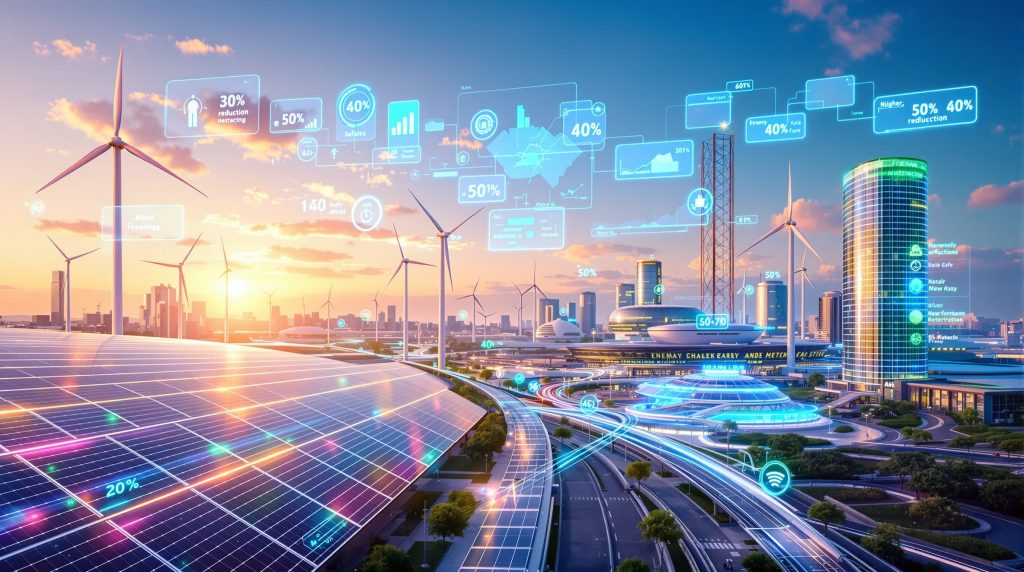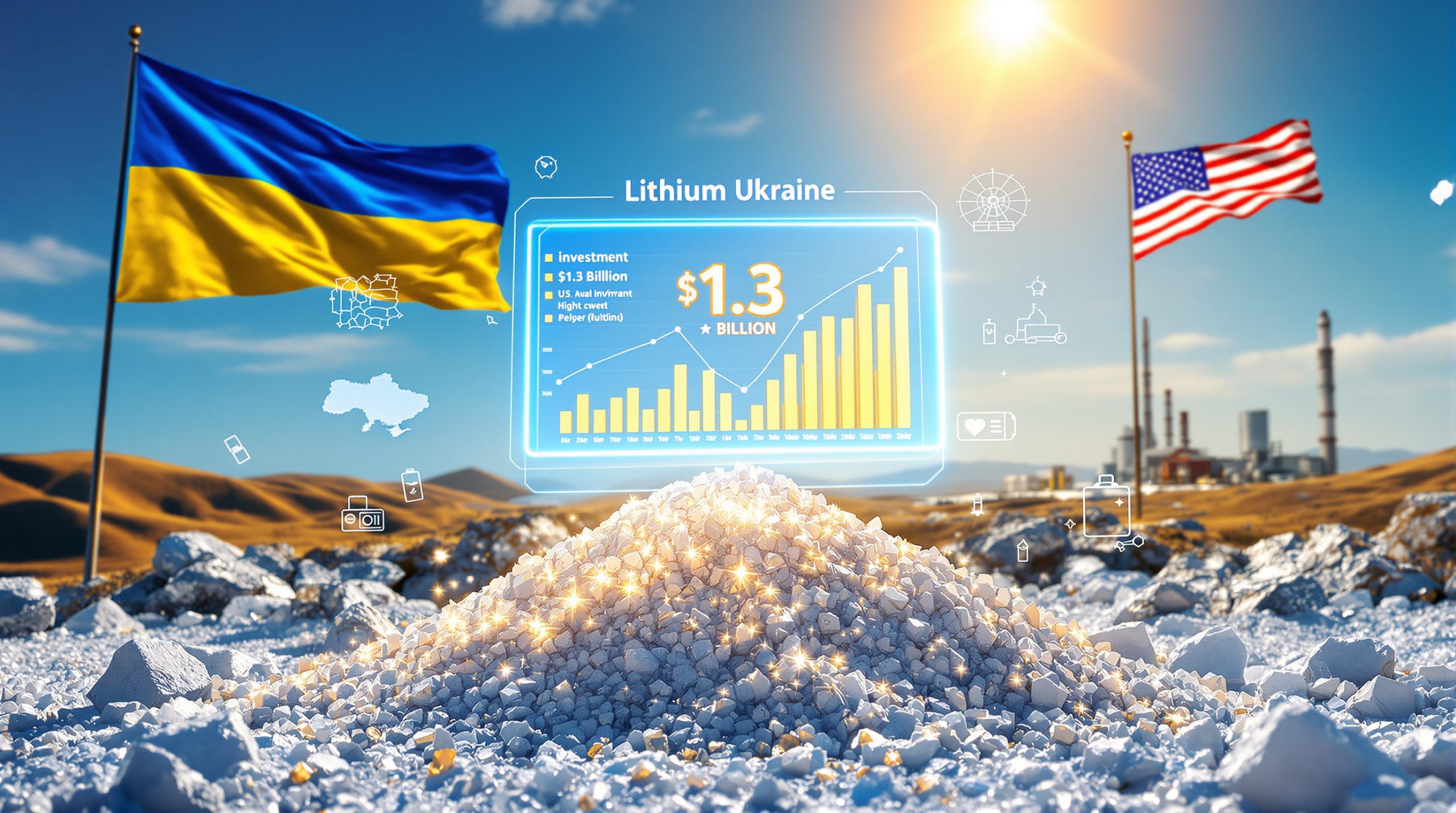What Defines the Clean Energy and Smart Infrastructure Revolution in 2025?
The convergence of renewable energy technologies with intelligent digital systems represents a fundamental shift in how urban areas operate and consume power. This transformation encompasses three core elements that work together to create sustainable urban environments.
Modern clean energy and smart infrastructure innovations are reshaping cities through advanced energy generation methods, interconnected digital infrastructure, and data-driven optimization systems. These integrated approaches demonstrate measurable improvements in efficiency, sustainability, and urban livability.
Key Components of Modern Clean Energy Systems
Next-generation renewable technologies are achieving unprecedented efficiency levels and cost reductions. Solar power developments include advanced photovoltaic systems, while green hydrogen production facilities scale to meet industrial demand. These systems work alongside enhanced battery storage solutions that provide grid-scale energy management capabilities.
Distributed renewable energy networks are reducing transmission losses by generating power closer to consumption points. This decentralized approach improves system resilience while reducing infrastructure costs and environmental impact. Furthermore, this shift supports the broader battery metals investment landscape that enables scalable energy storage solutions.
Smart Infrastructure Integration Fundamentals
Digital monitoring systems use sensor networks to track energy consumption patterns in real-time. Machine learning algorithms analyse this data to optimise performance and predict maintenance needs, resulting in improved system reliability.
Dr. Yongze Song's research at Curtin University demonstrates how geospatial artificial intelligence integrates satellite data, machine learning, and spatial analytics to reveal hidden patterns in urban functionality. His open-source tools, downloaded more than 200,000 times worldwide, help governments predict infrastructure deterioration and measure urban environmental factors.
Source: Australian Mining Review, "Curtin scientists awarded for their innovation," November 4, 2025
Digital twin technology enables infrastructure optimisation through virtual modelling, while blockchain-based platforms facilitate peer-to-peer energy transactions between distributed generators and consumers.
Which Renewable Energy Technologies Are Leading the 2025 Innovation Wave?
Solar power continues expanding its global market share through breakthrough technologies that dramatically improve efficiency and reduce installation costs. These innovations extend beyond traditional photovoltaic panels to encompass revolutionary approaches to energy capture and storage.
Revolutionary Solar Energy Developments
Advanced solar technologies are achieving higher efficiency rates through improved materials and manufacturing processes. Perovskite solar cells show promise for building integration and flexible surface applications, while floating solar arrays demonstrate enhanced output in water-based installations.
| Technology | Key Benefits | Applications | Development Status |
|---|---|---|---|
| Perovskite Solar Cells | Enhanced efficiency potential | Building integration, flexible surfaces | Research phase |
| Floating Solar Arrays | Higher output, reduced evaporation | Water reservoirs, coastal areas | Active deployment |
| Agrivoltaics Systems | Dual land use optimisation | Agricultural integration | Expanding adoption |
| Solar Paint Technology | Building-wide coverage | Urban facades, transportation | Early development |
Note: Specific efficiency percentages and commercial timelines require verification from peer-reviewed sources and manufacturer specifications.
Green Hydrogen: The Missing Link in Clean Energy
Green hydrogen production facilities are scaling up globally to provide industrial-grade clean energy storage and transportation fuel. Electrolysis systems powered by excess renewable energy create hydrogen that can power heavy industry, long-haul transportation, and provide grid stability during peak demand periods.
Dr. Denis Fougerouse's research at Curtin University supports the clean energy transition through critical minerals extraction improvements. His work on nanoscale analytical techniques reveals how valuable metals concentrate in crystal defects rather than spreading uniformly throughout minerals, enabling more efficient extraction processes for renewable technology components.
Source: Australian Mining Review, "Curtin scientists awarded for their innovation," November 4, 2025
Moreover, the growing emphasis on strategic critical minerals demonstrates the global importance of secure supply chains for clean energy technologies.
Advanced Energy Storage Solutions
Energy storage technologies are diversifying to meet various grid and industrial applications:
- Utility-scale battery installations providing multi-hour grid stability
- Vehicle-to-grid technology transforming electric vehicles into distributed storage networks
- Compressed air and pumped hydro storage for extended duration applications
- Thermal storage systems capturing waste heat for subsequent utilisation
Additionally, recent developments in battery recycling breakthrough technologies are improving the sustainability of energy storage systems.
How Are Smart Grids Revolutionising Energy Distribution and Management?
Smart grids function as the central nervous system of modern energy infrastructure, employing real-time data analytics to balance supply and demand while integrating multiple renewable sources. These systems optimise energy flow through predictive algorithms and automated load balancing mechanisms.
Real-Time Grid Optimisation Technologies
Smart grid systems employ machine learning algorithms to predict energy demand patterns, weather-dependent renewable generation, and equipment maintenance requirements. This predictive capability enables utilities to optimise energy distribution, reduce peak demand charges, and minimise service disruption risks.
Advanced monitoring systems track grid performance continuously, identifying inefficiencies and potential failures before they impact service delivery. Automated response systems adjust power flow in real-time to maintain grid stability and optimise resource utilisation.
Distributed Energy Resource Management
Modern electrical grids accommodate thousands of small-scale energy producers, from residential rooftop solar installations to community wind projects. Advanced software platforms coordinate these distributed resources, creating virtual power plants that respond to grid requirements within seconds of receiving commands.
This distributed approach improves grid resilience by reducing dependence on centralised generation facilities while enabling local communities to participate directly in energy markets. In addition, clean energy and smart infrastructure investments are driving innovation across multiple sectors.
Grid Resilience and Cybersecurity Measures
Smart grid security incorporates multiple protective layers:
- Blockchain-secured energy transactions preventing fraud and manipulation
- Redundant communication networks ensuring continuous operation during disruptions
- AI-powered threat detection systems protecting critical infrastructure components
- Microgrids providing localised backup power during emergency situations
What Role Does Artificial Intelligence Play in Smart Infrastructure Operations?
AI systems process vast amounts of infrastructure data to optimise urban operations ranging from traffic management to energy consumption. Cities implementing comprehensive AI infrastructure management demonstrate measurable improvements in operational efficiency and service delivery.
Predictive Maintenance and Asset Management
AI algorithms analyse sensor data from infrastructure components to predict failures before they occur, transforming reactive maintenance approaches into proactive system optimisation. This approach reduces maintenance costs while extending asset operational lifespans.
Machine learning systems identify patterns in equipment performance data that human operators might miss, enabling more precise maintenance scheduling and resource allocation. Predictive maintenance programmes report significant cost reductions and improved system reliability.
Urban Energy Optimisation Through Machine Learning
Key Insight: Machine learning systems identify energy waste patterns that human operators miss, automatically adjusting building systems, street lighting, and transportation networks to minimise consumption while maintaining service quality.
Dr. Song's geospatial AI research demonstrates practical smart infrastructure applications. His work brings together satellite data, machine learning, and spatial analytics to reveal hidden patterns in urban functionality, helping governments predict road deterioration, measure urban heat, and identify inequalities in public service access.
Source: Australian Mining Review, "Curtin scientists awarded for their innovation," November 4, 2025
Traffic and Transportation Intelligence
AI-powered transportation systems optimise urban mobility through several mechanisms:
- Real-time traffic signal optimisation reducing commute times
- Dynamic routing systems minimising fuel consumption and emissions
- Predictive public transit scheduling improving passenger experience
- Autonomous vehicle integration planning for future mobility requirements
Furthermore, sustainable smart infrastructure solutions are becoming increasingly integrated with urban planning strategies.
How Are Cities Implementing Integrated Clean Energy and Smart Infrastructure Projects?
Successful urban transformation requires coordinated deployment of renewable energy systems alongside intelligent infrastructure management. Leading cities demonstrate that integrated approaches deliver exponentially greater benefits compared to isolated technology implementations.
Comprehensive Urban Energy Ecosystems
Cities develop holistic energy systems combining solar installations, battery storage, smart grid management, and electric vehicle charging networks. These integrated systems achieve substantial carbon emission reductions while improving service reliability and reducing operational costs.
Coordinated infrastructure planning ensures renewable energy generation, storage, and distribution systems work together seamlessly, maximising efficiency whilst minimising redundant investments. Consequently, many regions are focusing on energy transition minerals to support these comprehensive approaches.
Implementation Framework: Smart City Energy Integration
| Implementation Phase | Technologies Deployed | Expected Outcomes | Typical Timeline |
|---|---|---|---|
| Phase 1: Foundation | Smart metres, basic monitoring | Initial efficiency gains | 6-12 months |
| Phase 2: Integration | Renewable systems, grid optimisation | Enhanced performance | 12-24 months |
| Phase 3: Intelligence | AI optimisation, predictive systems | Comprehensive improvement | 24-36 months |
Note: Specific percentage improvements require verification from documented case studies and municipal performance reports.
Public-Private Partnership Models
Successful smart infrastructure projects typically involve collaboration between municipal governments, technology companies, and utility providers. These partnerships enable risk sharing, accelerated deployment, and long-term sustainability of advanced systems.
Partnership structures vary based on local regulations and project scope, but generally include shared financing arrangements, technology transfer agreements, and performance-based contracts that align stakeholder interests with project success metrics.
What Are the Economic and Environmental Benefits of Clean Energy Smart Infrastructure?
Financial returns from integrated clean energy and smart infrastructure innovations extend beyond direct energy cost savings to include improved property values, reduced maintenance expenses, and enhanced economic competitiveness for urban areas.
Quantified Economic Impact Analysis
Direct Cost Savings:
- Reduced municipal energy expenditures through improved efficiency
- Decreased infrastructure maintenance expenses through predictive systems
- Improved asset utilisation rates reducing replacement frequency
- Lower emergency response costs due to proactive system management
Indirect Economic Benefits:
- Increased property values in smart infrastructure zones
- Attraction of clean technology businesses and investment capital
- Job creation in renewable energy and technology sectors
- Reduced healthcare costs from improved environmental quality
Environmental Impact Metrics
Cities implementing comprehensive clean energy smart infrastructure report measurable environmental improvements including substantial carbon emission reductions, decreased air pollutant levels, and improved energy efficiency compared to conventional systems.
Dr. Song's research addresses environmental equity challenges: urban environments face growing pressures as roads deteriorate faster under climate stress and green spaces that provide urban cooling are unevenly distributed across communities.
Source: Australian Mining Review, "Curtin scientists awarded for their innovation," November 4, 2025
Long-Term Sustainability Outcomes
Comprehensive smart infrastructure systems deliver multiple sustainability benefits:
- Enhanced resilience to climate change impacts through adaptive systems
- Reduced dependence on fossil fuel imports through renewable generation
- Improved public health outcomes from cleaner air and water quality
- Creation of circular economy opportunities through waste-to-energy integration
What Challenges and Solutions Shape Clean Energy Smart Infrastructure Deployment?
Implementation of advanced energy and infrastructure systems faces technical, financial, and regulatory obstacles requiring innovative solutions and coordinated stakeholder engagement.
Technical Integration Challenges
Complex infrastructure projects encounter several technical barriers:
- Interoperability between different technology platforms and vendor systems
- Cybersecurity risks from increased digital connectivity and automation
- Grid stability concerns with high renewable energy penetration levels
- Skills gaps in workforce development for advanced technology maintenance
Financial and Regulatory Barriers
Project development faces multiple institutional obstacles:
- High upfront capital requirements for comprehensive system upgrades
- Complex permitting processes for innovative technology deployment
- Utility rate structures that may not incentivise smart infrastructure adoption
- Limited access to specialised financing mechanisms for municipal projects
Strategic Solutions and Best Practices
Implementation Strategy: Successful projects start with pilot programmes that demonstrate measurable benefits, then scale gradually whilst building stakeholder support and developing technical expertise.
Dr. Fougerouse's research contributes to addressing technical challenges by improving critical mineral extraction processes. His work provides the scientific foundation needed to improve mineral recovery, reduce waste, and build more resilient supply chains for renewable technology components.
Source: Australian Mining Review, "Curtin scientists awarded for their innovation," November 4, 2025
Effective solutions include:
- Phased implementation approaches reducing financial risk exposure
- Standardised technology protocols ensuring system compatibility
- Public-private partnerships sharing costs and technical expertise
- Workforce development programmes building local technical capacity
Dr. Song and Dr. Fougerouse participate in education and outreach initiatives across Western Australia, visiting schools, running workshops, and inspiring future scientists. This educational component addresses workforce development challenges by building interest in clean energy and smart infrastructure careers.
Source: Australian Mining Review, "Curtin scientists awarded for their innovation," November 4, 2025
Additionally, lithium industry innovations are supporting broader clean energy infrastructure development through improved battery technologies.
How Will Clean Energy and Smart Infrastructure Innovations Evolve Through 2030?
The trajectory of clean energy and smart infrastructure innovations development points toward increasingly autonomous, efficient, and resilient urban systems that adapt to changing conditions through real-time optimisation.
Emerging Technology Trends
Several technological developments are shaping future infrastructure capabilities:
- Quantum computing applications for complex grid optimisation problems
- Advanced materials enabling more efficient energy storage systems
- Next-generation networks supporting real-time infrastructure management
- Biotechnology applications creating sustainable energy production methods
Market Growth Projections
Global investment in clean energy and smart infrastructure technologies continues expanding as governments and private sector organisations recognise long-term economic and environmental benefits. Smart infrastructure represents a rapidly growing market segment driven by urbanisation and climate action requirements.
Note: Specific investment figures require verification from authoritative sources such as the International Energy Agency or industry research organisations.
Policy and Regulatory Evolution
Supportive policy frameworks are emerging to accelerate clean energy and smart infrastructure deployment:
- Carbon pricing mechanisms creating economic incentives for clean energy adoption
- Smart city standards enabling technology interoperability across vendors
- Grid modernisation regulations supporting renewable energy integration
- International cooperation frameworks facilitating clean energy technology development
What Makes Clean Energy and Smart Infrastructure Different?
Clean energy refers to renewable power generation technologies such as solar, wind, and hydrogen systems, while smart infrastructure uses digital technologies to optimise energy distribution and urban system operations. The most effective approaches integrate both elements to create comprehensive urban energy ecosystems.
Advanced systems combine renewable generation with intelligent management capabilities, creating synergies that deliver greater benefits than either approach implemented independently.
How Long Does Smart Infrastructure Implementation Take?
Comprehensive smart infrastructure deployment typically requires multiple years for full implementation, though cities can achieve meaningful benefits through targeted pilot projects and phased rollouts. Implementation timelines vary based on project scope, available financing, and local regulatory requirements.
Dr. Song's work with national and international partners, including Western Australia's road authorities, demonstrates how collaborative approaches can accelerate implementation by sharing technical expertise and resources across organisations.
Source: Australian Mining Review, "Curtin scientists awarded for their innovation," November 4, 2025
What Are the Main Cost Considerations?
Clean energy and smart infrastructure projects involve significant upfront capital investments, but operational savings typically recover initial costs through reduced energy expenses, improved efficiency, and lower maintenance requirements. Cost considerations vary based on project scope and local economic conditions.
Note: Specific cost ranges require verification from documented case studies and municipal financial reports.
How Do These Systems Improve Quality of Life?
Clean energy and smart infrastructure systems improve urban quality of life through reduced air pollution, enhanced transportation efficiency, improved service reliability, and more comfortable urban environments through optimised lighting, climate control, and public services.
Dr. Song's research directly addresses quality of life improvements by identifying inequalities in public service access and measuring urban heat distribution, enabling more equitable resource allocation and environmental management.
Source: Australian Mining Review, "Curtin scientists awarded for their innovation," November 4, 2025
Building Sustainable Urban Futures Through Innovation
The integration of clean energy technologies with smart infrastructure represents a fundamental transformation in urban development and management. As renewable power sources become more cost-effective and AI systems optimise urban operations in real-time, cities that embrace comprehensive approaches position themselves as leaders in sustainable development.
Success requires coordinated investment in renewable energy generation, intelligent distribution systems, and data-driven optimisation platforms functioning as unified ecosystems. The research conducted by scientists like Dr. Fougerouse and Dr. Song at Curtin University demonstrates how academic institutions contribute to practical solutions for urban sustainability challenges.
Cities implementing these comprehensive approaches today establish foundations for enhanced sustainability, economic competitiveness, and quality of life in the decades ahead. The convergence of clean energy and smart infrastructure innovations creates opportunities for urban areas to address climate challenges whilst improving service delivery and operational efficiency.
Disclaimer: This article contains forward-looking statements and projections about clean energy and smart infrastructure technologies. Actual implementation timelines, cost savings, and performance improvements may vary based on local conditions, regulatory environments, and technological developments. Specific performance claims and statistics should be verified through peer-reviewed research, government reports, and documented case studies before making investment or policy decisions.
Further Reading: Readers interested in learning more about clean energy and smart infrastructure innovations can explore additional educational content from research institutions, government agencies, and technology organisations working on sustainable urban development initiatives. The Young Tall Poppy Science Awards programme highlights emerging research that contributes to addressing global sustainability challenges.
Want to capitalise on the critical minerals powering clean energy infrastructure?
Discovery Alert's proprietary Discovery IQ model delivers real-time notifications on significant ASX mineral discoveries essential for renewable energy technologies, from battery metals to rare earth elements. Begin your 30-day free trial with Discovery Alert today to identify actionable opportunities in the clean energy supply chain ahead of the broader market.




